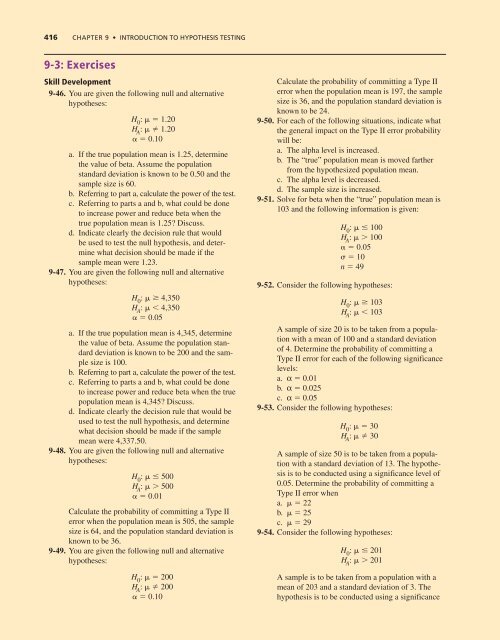Chapter 9: Introduction to Hypothesis Testing
Chapter 9: Introduction to Hypothesis Testing
Chapter 9: Introduction to Hypothesis Testing
Create successful ePaper yourself
Turn your PDF publications into a flip-book with our unique Google optimized e-Paper software.
416 CHAPTER 9 • INTRODUCTION TO HYPOTHESIS TESTING<br />
9-3: Exercises<br />
Skill Development<br />
9-46. You are given the following null and alternative<br />
hypotheses:<br />
H 0<br />
: 1.20<br />
H A<br />
: 1.20<br />
0.10<br />
a. If the true population mean is 1.25, determine<br />
the value of beta. Assume the population<br />
standard deviation is known <strong>to</strong> be 0.50 and the<br />
sample size is 60.<br />
b. Referring <strong>to</strong> part a, calculate the power of the test.<br />
c. Referring <strong>to</strong> parts a and b, what could be done<br />
<strong>to</strong> increase power and reduce beta when the<br />
true population mean is 1.25? Discuss.<br />
d. Indicate clearly the decision rule that would<br />
be used <strong>to</strong> test the null hypothesis, and determine<br />
what decision should be made if the<br />
sample mean were 1.23.<br />
9-47. You are given the following null and alternative<br />
hypotheses:<br />
H 0<br />
: 4,350<br />
H A<br />
: 4,350<br />
0.05<br />
a. If the true population mean is 4,345, determine<br />
the value of beta. Assume the population standard<br />
deviation is known <strong>to</strong> be 200 and the sample<br />
size is 100.<br />
b. Referring <strong>to</strong> part a, calculate the power of the test.<br />
c. Referring <strong>to</strong> parts a and b, what could be done<br />
<strong>to</strong> increase power and reduce beta when the true<br />
population mean is 4,345? Discuss.<br />
d. Indicate clearly the decision rule that would be<br />
used <strong>to</strong> test the null hypothesis, and determine<br />
what decision should be made if the sample<br />
mean were 4,337.50.<br />
9-48. You are given the following null and alternative<br />
hypotheses:<br />
H 0<br />
: 500<br />
H A<br />
: 500<br />
0.01<br />
Calculate the probability of committing a Type II<br />
error when the population mean is 505, the sample<br />
size is 64, and the population standard deviation is<br />
known <strong>to</strong> be 36.<br />
9-49. You are given the following null and alternative<br />
hypotheses:<br />
H 0<br />
: 200<br />
H A<br />
: 200<br />
0.10<br />
Calculate the probability of committing a Type II<br />
error when the population mean is 197, the sample<br />
size is 36, and the population standard deviation is<br />
known <strong>to</strong> be 24.<br />
9-50. For each of the following situations, indicate what<br />
the general impact on the Type II error probability<br />
will be:<br />
a. The alpha level is increased.<br />
b. The “true” population mean is moved farther<br />
from the hypothesized population mean.<br />
c. The alpha level is decreased.<br />
d. The sample size is increased.<br />
9-51. Solve for beta when the “true” population mean is<br />
103 and the following information is given:<br />
H 0<br />
: 100<br />
H A<br />
: 100<br />
0.05<br />
10<br />
n 49<br />
9-52. Consider the following hypotheses:<br />
H 0<br />
: 103<br />
H A<br />
: 103<br />
A sample of size 20 is <strong>to</strong> be taken from a population<br />
with a mean of 100 and a standard deviation<br />
of 4. Determine the probability of committing a<br />
Type II error for each of the following significance<br />
levels:<br />
a. α 0.01<br />
b. α 0.025<br />
c. α 0.05<br />
9-53. Consider the following hypotheses:<br />
H 0<br />
: 30<br />
H A<br />
: 30<br />
A sample of size 50 is <strong>to</strong> be taken from a population<br />
with a standard deviation of 13. The hypothesis<br />
is <strong>to</strong> be conducted using a significance level of<br />
0.05. Determine the probability of committing a<br />
Type II error when<br />
a. 22<br />
b. 25<br />
c. 29<br />
9-54. Consider the following hypotheses:<br />
H 0<br />
: 201<br />
H A<br />
: 201<br />
A sample is <strong>to</strong> be taken from a population with a<br />
mean of 203 and a standard deviation of 3. The<br />
hypothesis is <strong>to</strong> be conducted using a significance

















